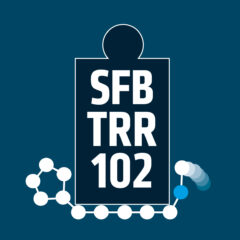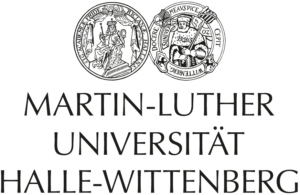Investigating chaperone activity and gelation of human aB eye lens crystallin protein using solid state NMR
by Maria Camilles
Halbleitende Blockcopolymere und Modellsysteme: Der Einfluss von molekularem Aufbau und molekularer Dynamik auf die Strukturbildung (Rehearsal) by Matthias Fischer
Location: Halle University, von-Danckelmann-Platz 3, SR 1.03
Time: 3.20pm-5.00pm
Abstracts
Investigating chaperone activity and gelation of human aB eye lens crystallin protein using solid state NMR
Maria Camilles
Crystallins are the major vision-related (i.e. refractive) proteins found in the eye lens. The mammalian lens consists of three classes of structural proteins, i.e a-, b- and g-crystallins. The former also acts as chaperone [1]. Commonly, proteins are subject to a continuous degradation and replacement process, but the eye lens proteins have to remain stable and soluble for a lifetime [2]. Heat shock or other stressors can cause aggregation and lead to cataract; thus, the major function of the chaperone is to prevent aggregation. Here we investigate aB-crystallin proteins which is highly expressed in both eye lens as well as muscle tissues and also widely known for its chaperoning ability. We use solid state MAS NMR (SS NMR) [3] to probe the changes that occur at a specific site when a target protein (gB-crystallin) binds to it and study the effect of protein concentrations on the protection ability of aB-crystallin proteins.
In our previous work [4] we found out that a- crystallin upon aggregation forms a gel as opposed to gB crystallin which forms a solid precipitate. The studies based on a-crystallin gels are limited, so the mechanism of aggregation and gelation of these proteins are unclear. We would therefore also investigate the gelation of a-crystallin protein using SS NMR and the changes in the crystallin backbone are to be probed, which can clarify whether the a-crystallin loses it native structure or remains unaffected when it transforms into a gel. Then the aim here is to correlate rheology, Electron Microscopy and MAS NMR to investigate the effect of protein concentration and ionic strengths on the gelation of haB crystallin. This should give some insights into the mechanism and dynamic properties of the a-crystallin protein gel.
References:
[1] Bloemendal, H. et al. Ageing and vision: structure, stability and function of lens crystallins, Biophys. Mol.Biol. 2004, 86:407–485.
[2] Delaye, M. Tardieu, A., Short-range order of crystallin proteins accounts for eye lens transparency.Nature. 1983, 302:415–417.
[3] Mainz, A. et al., The chaperone aB-crystallin uses different interfaces to capture an amorphous and an amyloid client, Struct. Mol. Biol., 2015, 22:898-908.
[4] Camilles et al., Quantitative NMR study of heat-induced aggregation of eye-lems crystallin proteins under crowding conditions, BBA Prot. Proteom., 2018, 1866: 1055-1061.
Halbleitende Blockcopolymere und Modellsysteme: Der Einfluss von molekularem Aufbau und molekularer Dynamik auf die Strukturbildung
Matthias Fischer
Die Versorgung der Weltbevölkerung mit regenerativen Energien stellt eine der größten Herausforderungen des 21. Jahrhunderts dar. Organische Solarzellen können dank niedriger Herstellungs- und Verarbeitungskosten, ihrer mechanische Flexibilität und eines geringen Gewichts dazu einen entscheidenden Beitrag leisten. Für eine hohe Effizienz und dementsprechend eine gute Ladungsträgerseparation ist jedoch eine nanostrukturierte Morphologie mit Grenzflächen zwischen einem Lochleiter- (Donor) und einem Elektronenleitermaterial (Akzeptor) auf der Größenordnung von wenigen 10 nm notwendig. Dieser Vortrag widmet sich dem Einfluss der chemischen Struktur und der molekularen Dynamik auf die Mikrophasenseparation der Blockcopolymere und die Kristallisation der Homopolymere. Dazu werden die Ergebnisse der Charakterisierung zweier Materialsysteme von Donor-Akzeptor-Blockcopolymeren und der zugrundeliegenden Homopolymere vorgestellt: genutzt werden ein Poly(3-hexylthiophen) (P3HT)-haltiger Donor und ein [6,6]-Phenyl-C61-Buttersäuremethylester (PCBM)- bzw. Perylenbisimid (PBI)-haltiger Akzeptor. Als zentrale Methoden der Strukturaufklärung wurden Röntgenstreuung, dynamische Differenzkalorimetrie sowie verschiedene Mikroskopietechniken verwendet. Die Glasübergangstemperatur wird als entscheidender Designparameter für die Ausbildung einer Mikrophasenseparation der Blockcopolymere, sowie einer flüssigkristallinen Ordnung der Akzeptorpolymere und die Ladungsträgermobilität identifiziert. Des Weiteren zeigen die Ergebnisse die Bedeutung der Aggregation und der π-π-Orientierung für den Ladungstransport in halbleitenden Polymeren.




